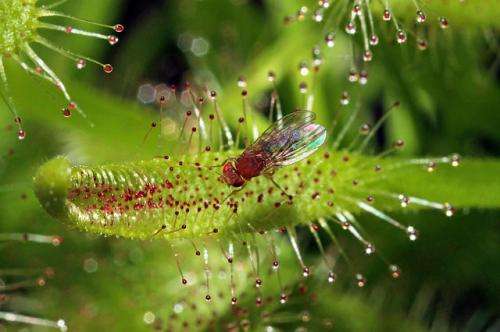Why fruit flies are a good genetic model for human disease study

If you have a Facebook account, you are likely to have seen someone pour an ice bucket on themselves in the name of raising awareness for amyotropic lateral sclerosis (ALS). ALS is a disease that affects nerve cells in the brain, and it falls into a class of diseases known as neurodegenerative, which include diseases such as Parkinson's, Alzheimer's and Huntington's. All of them are incurable and claim many lives around the world. These diseases can be caused by genetic mutations, but our understanding of what causes these remains poor.
A study, conducted by Manish Jaiswal and colleagues and led by Hugo Bellen and Michael Wangler at the Baylor College of Medicine, just published in Cell, takes a key step forward. They identified hundreds of new mutations in specific genes that are associated with various aspects of the development, function and maintenance of neural system in the fruit fly Drosophila melanogaster. The fruit fly is a stand-in for humans, and allows investigation of the molecular mechanisms of 26 human diseases, including ALS.
Researchers could use Drosophila melanogaster, because it is a well-established model organism to understand the molecular mechanisms of many human diseases. This is because: about 75% of human disease-causing genes are found in the fly in a similar form, it is easy to work with and breeds quickly, and many tools are available to manipulate any genes in it.
Messing with a fruit fly
The standard way of learning about genes is by studying the effect on the fly when a specific gene is "knocked out" from its genome. However, this strategy is sometimes ineffective – for instance, if the gene knocked out is an essential gene required for growth and development, then the fly will not fully grow, rendering the effort useless.
The authors overcame this limitation by inducing mutations in just a few cells in the fly, so that even if an essential gene is mutated, it does not kill the fly during its embryo-to-adult development. The effect of that mutation can be studied by looking at the tissue or organ where that mutation was supposed to act.
This is an important method because it helps to do experiments that can't be done in humans. For instance, looking at the full genetic data of two siblings suffering from microcephaly – a disease in which size of the head is much smaller than expected – the researchers found that a specific gene, called ANKLE2, was mutated in both. This could be coincidence. But given there are 20,000 genes in the human genome, the chance of such a coincidence are quite low. To find out whether ANKLE2 is causing microcephaly, the researchers would need to conduct gene manipulation experiments in humans. Such experiments, however, are unethical.
Genetic shortcut
That's when studying fly and human genetics together becomes crucial. The authors found that flies with mutations in the same gene had small brains too. However, when the human ANKLE2 gene was introduced in these mutant flies, they had a normal brain size, providing evidence from the fly that ANKLE2 is the culprit.
This technique allowed the authors to isolate 614 new mutations in 165 genes that affect the development, function and maintenance of a functional neural system. But what is perhaps more important is that, these results have helped the authors to suggest a new method for identifying various disease-causing human genes by looking at the mutations in the genomes of patients alongside the mutations in corresponding Drosophila genes. They find that the disease-causing genes in humans have more than one copy of them in the fly, so if one can enlist which genes have more than one copy in the fly, they are likely to be disease-causing in humans.
As more people use this method, we will get closer and closer to finally understanding the genetic basis of many neurological and neurodegenerative diseases.
Journal information: Cell
Source: The Conversation
This story is published courtesy of The Conversation (under Creative Commons-Attribution/No derivatives).
![]()

















